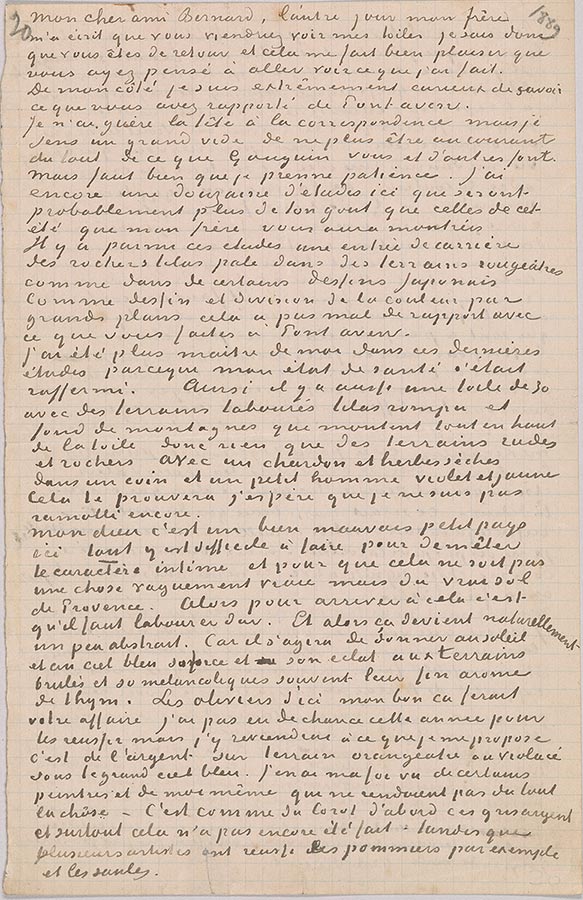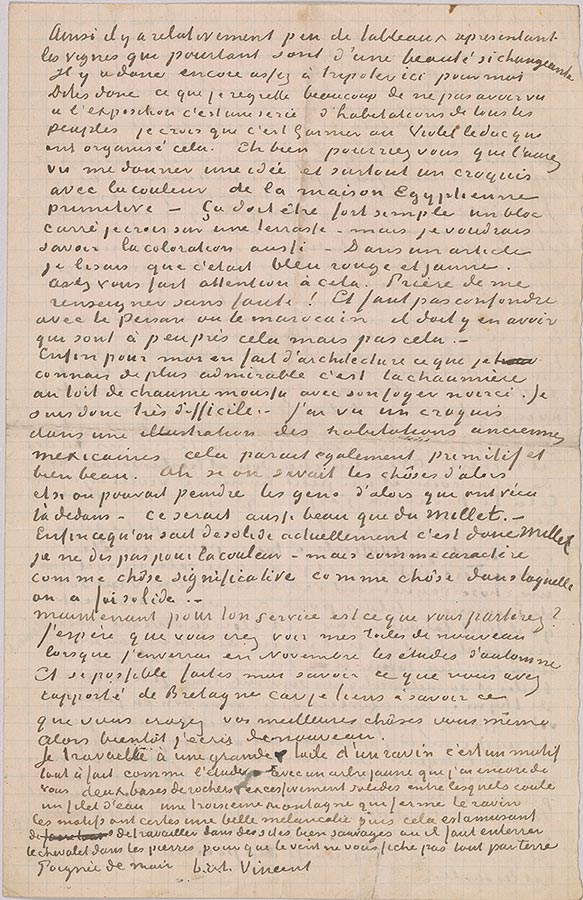Letter 21, page 1

Vincent van Gogh, letter to Émile Bernard, Arles, 8 October 1888, Letter 21, page 1
Thaw Collection, given in honor of Charles E. Pierce, Jr., 2007
My dear friend Bernard,
The other day my brother wrote to me that you were going to come to see my canvases; so I know
that you're back, and I'm very pleased that you thought of going to see what I've done.
For my part, I'm extremely curious to know what you have brought back from Pont-Aven.
I hardly have a head for writing, but I feel a great emptiness in no longer being at all up to date
with what Gauguin, you and others are doing. But I really must have patience. I have another dozen
studies here, which will probably be more to your taste than the ones from this summer that my
brother will have shown you.
Among these studies there is an entrance to a quarry, pale lilac rocks in reddish earth, as in
certain Japanese drawings. In terms of design and the division of color into large planes, it's quite
closely related to what you're doing in Pont-Aven.
I had more control over myself in these latest studies, because my state of health had firmed
up. So there's also a no. 30 canvas with broken lilac plowed fields and a background of mountains
that go all the way up the canvas; so nothing but rough ground and rocks, with a thistle and dry
grass in a corner, and a little violet and yellow man. That will prove, I hope, that I haven't yet
gone soft.
Dear God, this is a pretty awful little part of the world, everything's hard to do here, to disentangle
its intimate character, and so that it's not something vaguely true, but the true soil of
Provence. So to achieve that, you have to toil hard. And so it naturally becomes a little abstract.
Because it will be a question of giving strength and brilliance to the sun and the blue sky, and to the
scorched and often so melancholy fields their delicate scent of thyme. The olive trees down here,
my good fellow, they'd suit your book; I haven't been fortunate this year in making a success of
them, but I'll go back to it, that's my intention. It's silver against orangish or purplish earth, under
the great blue sky. Well now, I've seen some by certain painters, and by myself, which didn't render
the thing at all. Those silver grays are like Corot first of all, and that, above all, hasn't been done
yet—while several artists have been successful with apple-trees, for example, and willows.
© 2007 Van Gogh Museum, Amsterdam
Letter 21, page 2

Vincent van Gogh, letter to Émile Bernard, Arles, 8 October 1888, Letter 21, page 2
Thaw Collection, given in honor of Charles E. Pierce, Jr., 2007
So there are relatively few paintings of vineyards, which are nevertheless of such changing
beauty. So there's still plenty for me to fiddle around with here.
Look here, what I very much regret not having seen at the Exhibition is a series of houses of all
the nations; I think it was Garnier or Viollet-le-Duc who organized it. Well, could you, who will
have seen it, give me an idea, and especially a sketch with the color of the primitive Egyptian house?
It must be very simple, a square block, I believe, on a terrace—but I should like to know the coloring
too. I was reading in an article that it was blue, red and yellow.
Did you pay attention to it? Please inform me without fail! And it must not be confused with
the Persian or the Moroccan; there must be some that are more or less it, but not it.
Anyway, for me the most wonderful thing that I know in terms of architecture is the cottage
with a mossy thatched roof, with its blackened hearth. So I'm very fussy. I saw a sketch of ancient
Mexican houses in an illustrated magazine; that, too, seemed primitive and really beautiful. Ah, if
only one knew the things of those days, and if one could paint the people of those days who lived
in them—it would be as beautiful as Millet. Anyway, what we do know that's solid these days, then,
is Millet; I'm not talking about color—but as character, as something significant, as something in
which one has solid faith.
Now, about your service; will you go? I hope you'll go to see my canvases again when I send the
studies of autumn, in November. And if possible let me know what you've brought back from Brittany,
because I'd really like to know what you yourself believe to be your best things. So I'll write
again soon.
I'm working on a large canvas of a ravine; it's a subject just like the study with a yellow tree
that I still have from you, two bases of extremely solid rocks, between which a trickle of water
flows, a third mountain that closes off the ravine. These motifs certainly have a beautiful melancholy,
and it's enjoyable to work in really wild sites where you have to bury your easel in the stones
so that the wind doesn't send everything flying to the ground.
Handshake.
Yours,
Vincent
© 2007 Van Gogh Museum, Amsterdam